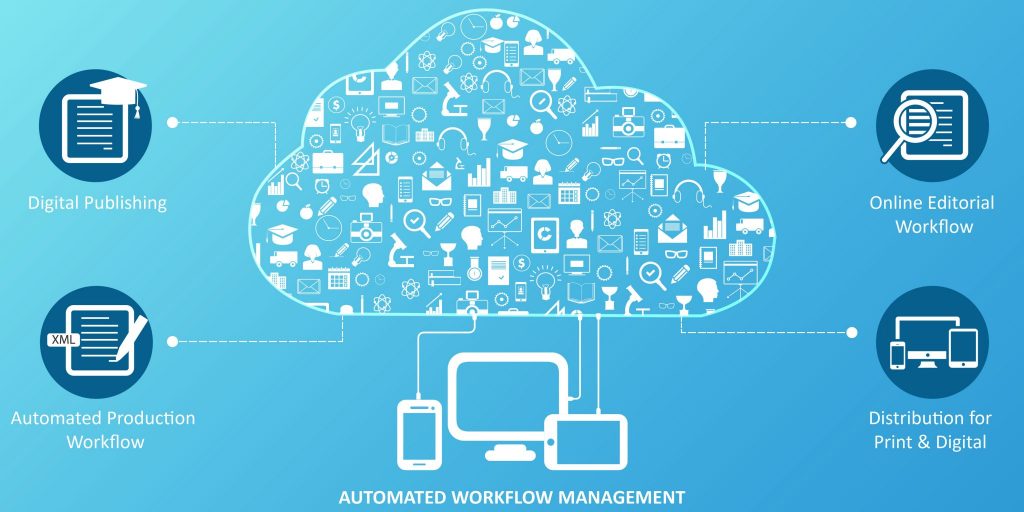
5 Ways Automated Workflow Makes Journal Publishing Smarter & Faster
In today’s academic world, research content has to pass through several layers of scrutiny to meet desired levels of quality. Added to this is the constant need for academic publishers to ensure a smooth workflow between authors, editors, reviewers, and production so that the journal gets published on time.
To survive in the fast-paced, competitive environment, academic publishers need to replace their traditional workflow with digital workflow management systems. The last few years have, in fact, witnessed many publishers taking the digital route to embracing a cloud-based workflow management systems.
It simplifies the journal publishing journey with automation, making it easier to coordinate & update the manuscript, efficient versioning & accommodation of changes and faster publishing in multiple formats for different platforms.
Still wondering if it is right for your publishing portfolio?
6 Advantages of Migrating Academic Publishing to a Cloud-based Workflow Management System -
Single-source publishing:
Cut away from article versions mayhem by working on a single document that undergoes the journal publishing lifecycle and author/reviewer pathways. With everyone now on the same page, it becomes easier for journal publishers to co-ordinate with authors, reviewers & editors to incorporate comments and finalize the article.
Cloud publishing platforms like Kitaboo Journal can also help you in rapid XML-to-PDF creation as it weaves together all the pre-requisites on a single source file. It streamlines editing, composing, correcting text and publishing in multiple formats using one source file. All this with no hardware or software installations – straight to work in no time.
Cloud-based workflow:
Adopting a cloud-based workflow management system (WMS) ensures that authors, editors, reviewers, and production no longer have to work in silos. A WMS allows seamless communication and exchange of data, thereby eliminating redundancies and making the entire workflow more agile and transparent.
To further illustrate the point, platforms like Kitaboo Journal, offer integration with an online XML-based editor, which can be used by authors and copy editors to perform edits; and integration with a composition engine to generate PDF formats of scholarly articles. Besides, it also offers an enrichment tool to add interactivity to the content.
eProofing on XML:
The arrival of digital publishing, eBooks and eJournals has led to the rise of digital workflow and online proofing systems. Although some would still take a print out to proof, most of them prefer a PDF file as the most convenient format for copy-editing & proofing articles. However, many progressive scholarly publishing companies are already on the next generation technology of online proofing on XML workflow.
The automated workflow platform such as used by Kitaboo Journal creates an XML proofing environment for a seamless tracking system between author, review, and editorial to comprehend the changes faster. It is more convenient, accurate and provides transparency thereby reducing time & efforts of the editorial team on hand, and also saves cost to the company.
Online PDF generation:
With more than one journal in the workflow and different subjects to publish, it is an arduous journey from manuscript to issue publishing for the periodicals. Each journal has unique editorial guidelines, page format, cover design and content methodology.
Easy drag and pull templates help in the creation of pre-set designs in a master press with quality assurance benchmarks. The cloud publishing platform becomes your single source for PDF approval for a printer, a web PDF, and an online XML.
Multi-product publishing:
It is now the norm for academic publishers to support all types of platforms including desktop and mobile devices, such as smartphones, Kindle, iPad, etc. A cloud-based automated workflow allows content to be processed in a single XML format, and once finalized, it can be transformed for various online platforms in formats such as ePub, HTML, PDF and more.
With easy accessibility to smartphones and the Internet, more and more people are now using their mobile devices to access content online than rely on the print version. Using Kitaboo Journal, academic publishers can accommodate deliverable for both the print and online media, and also distribute their content across multiple platforms.
Kitaboo Journal makes academic publishing simpler, smarter and faster
Gain a competitive edge with digital workflow management systems for quality, speed, and productivity. If you are looking for an ideal workflow management system for your academic publishing needs, you will find a perfect solution in Kitaboo Journal, an award-winning eBook publishing platform.
Kitaboo helps to create multimedia-rich, interactive and mobile-friendly academic books and journals. Talk to us about your publishing portfolio, and we will tell the simplest route to make your workflow faster and smarter.
Discover how a mobile-first training platform can help your organization.
Kitaboo is a cloud-based platform to create, deliver & track mobile-first interactive training content.





